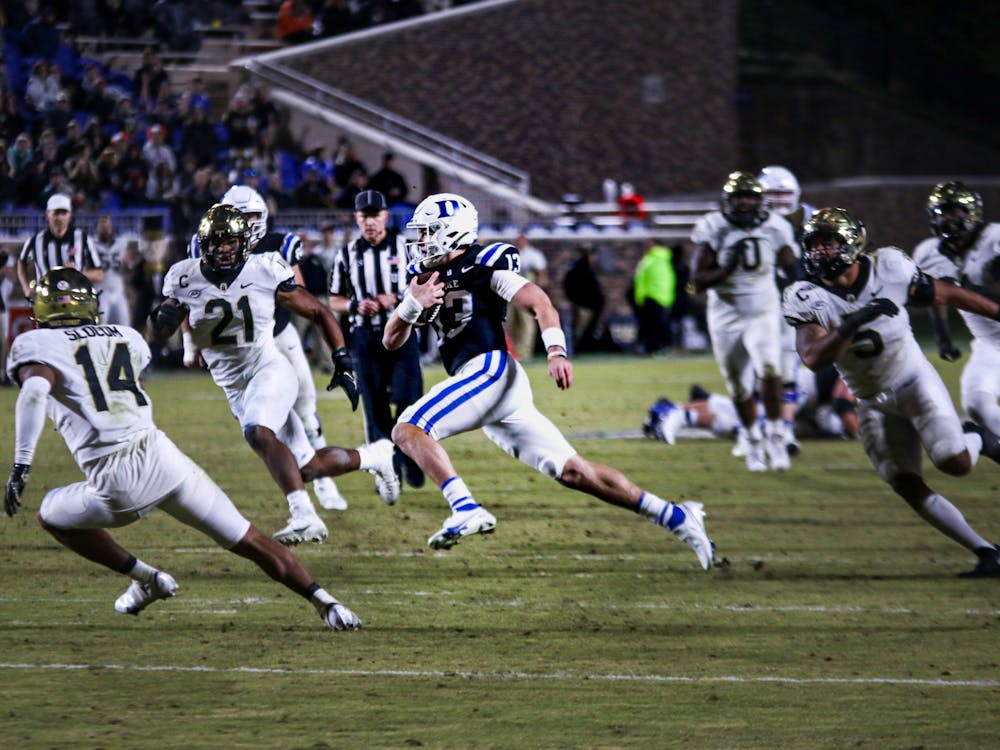In years past, seeing teams like No. 9 Clemson and No. 13 Notre Dame on the schedule would have meant near-certain defeat for Duke. To put it simply, the Blue Devils have historically not had a program that strikes fear in the hearts of their gridiron opponents. They sit below .500 in all-time winning percentage at an uninspiring .471, and have finished with a winning record just six times since 2000. There were three seasons during that stretch where Duke failed to win a single game.
Despite all that, this year feels different. For the first time in a while, it seems like there is a non-zero chance Duke manages to snatch one from the Tigers or Fighting Irish.
Unfortunately, I must be the bearer of bad news. Duke has been here before. In fact, an almost identical situation played out in the 90s under the direction of Fred Goldsmith — and it didn’t go so well.
The year was 1994. Duke football was in dire straits. The program had not had a winning season since its previous head coach, Steve Spurrier, had left the Blue Devils for Florida. Then-head coach Barry Wilson had just finished another lackluster season, going 3-8 overall and finishing seventh in the ACC. It was time for a change, and Goldsmith looked like exactly what the program needed.
He was coming off of a commendable tenure at Rice, where he had turned around a team that went 0-11 in 1988 to 6-5 in 1992. Resources were limited, but he had managed to save a program that appeared to be in a very bad situation. Goldsmith was then brought on to do something similar in Durham. He was a highly touted hire at the time, even earning the name of 1992 Sports Illustrated Coach of the Year for his time with the Owls.
In his first year, it seemed like Goldsmith was just what the Blue Devils had hoped for. He led them to an 8-4 record and a place in the Hall of Fame Bowl. His starting quarterback, Spence Fischer, played well in his junior season, averaging 207.7 yards per game through the air. Duke even beat Clemson 19-13.
There was a spark of hope coming into Goldsmith’s sophomore campaign. The Chronicle itself published a hype-piece for the season, as he brought back 45 lettermen and spoke of changes that would “mess up our opponents early.” Duke seemed poised to step up to the next level, with its second-year head coach leading the charge.
Alas, things fell apart. The Blue Devils went 3-8 in 1995, then 0-11 in 1996. Goldsmith was fired after two more years, never winning more than four games in a season again. Duke continued to flounder, and did not make a bowl game again until 2012 under the direction of former head coach David Cutcliffe.
In many ways, current head coach Mike Elko’s first year is similar to Goldsmith’s. He had a quarterback come into his own in Riley Leonard, the Blue Devils made it to a bowl game for the first time in years and there is finally hope instead of dread for Duke coming into Elko’s second year.
And why not? It’s hard for fans not to be excited about the direction in which the team is heading given the turnaround it just had. This is made doubly true when one considers Elko’s new contract extension, which will keep him with the Blue Devils until 2029. But the question looms: If Elko’s first year looked like Goldsmith’s, will he suffer in his second season the same way?
There is not any sure sign that Duke will regress this year, especially not to the point Goldsmith did. There are a few question marks in the depth chart, but nothing so egregious that it is guaranteed to sink the team. What is more important is that fans soften their expectations.
Most likely, the Blue Devils are not going to take one from either Clemson or Notre Dame. Duke probably will not make it above the No. 20-25 range in the AP poll, if it cracks the top 25 at all. This is not a make-or-break season for Elko; he will probably be here for several more years and there will likely be some grace from the higher-ups as he builds out his coaching staff and starts to bring in his own recruits.
Ultimately, the forecast for the future of Duke football is a murky one. There is no reason to believe Elko is doomed to fail. The back of one good season, no matter how good it was, is hardly enough to say that his tenure will be a resounding success. What matters is patience.
Goldsmith’s story, and a multitude of others from across college and pro sports, show us that a coach’s first year often does not tell us much in the grand scheme of things. Is Elko truly the answer? Is he just another Fred Goldsmith? Will he land somewhere in between? The answer, as much as it stings many Blue Devil fans to admit it, is that only time will tell.
I do not want to rain on anybody’s parade. It is entirely possible that Elko manages to build off of last year’s momentum and truly take Duke football to new heights. But we don’t know. Frankly, we won’t know for several more years. We might not know until 2029, when Elko’s contract is up. Until then, all we can do is watch and wait.
Editor's note: This piece is one of many in The Chronicle's 2023 Duke football preseason supplement. For the rest, click here.
Get The Chronicle straight to your inbox
Signup for our weekly newsletter. Cancel at any time.

